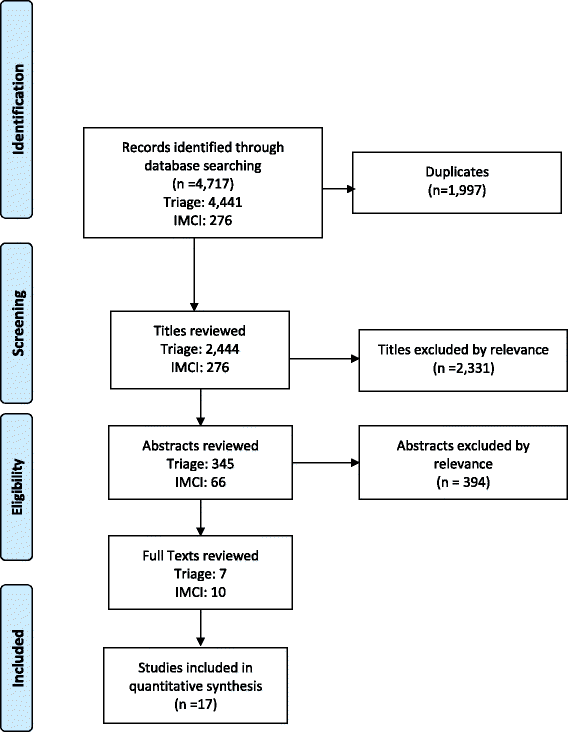Reliability and validity of pediatric triage tools evaluated in Low resource settings: a systematic review
- PMID: 28122537
- PMCID: PMC5267450
- DOI: 10.1186/s12887-017-0796-x
Reliability and validity of pediatric triage tools evaluated in Low resource settings: a systematic review
Abstract
Background: Despite the high burden of pediatric mortality from preventable conditions in low and middle income countries and the existence of multiple tools to prioritize critically ill children in low-resource settings, no analysis exists of the reliability and validity of these tools in identifying critically ill children in these scenarios.
Methods: The authors performed a systematic search of the peer-reviewed literature published, for studies pertaining to for triage and IMCI in low and middle-income countries in English language, from January 01, 2000 to October 22, 2013. An updated literature search was performed on on July 1, 2015. The databases searched included the Cochrane Library, EMBASE, Medline, PubMed and Web of Science. Only studies that presented data on the reliability and validity evaluations of triage tool were included in this review. Two independent reviewers utilized a data abstraction tool to collect data on demographics, triage tool components and the reliability and validity data and summary findings for each triage tool assessed.
Results: Of the 4,717 studies searched, seven studies evaluating triage tools and 10 studies evaluating IMCI were included. There were wide varieties in method for assessing reliability and validity, with different settings, outcome metrics and statistical methods.
Conclusions: Studies evaluating triage tools for pediatric patients in low and middle income countries are scarce. Furthermore the methodology utilized in the conduct of these studies varies greatly and does not allow for the comparison of tools across study sites.
Figures
References
-
- You D, Hug L, Chen Y. Levels and trends in child mortality. UNICEF. New York: UNICEF; 2014.
-
- Riviello ED, Letchford S, Achieng L, Newton MW. Critical care in resource-poor settings: lessons learned and future directions. Crit Care Med. 2011;39(4):860-7. - PubMed
Publication types
MeSH terms
LinkOut - more resources
Full Text Sources
Other Literature Sources


